Eighteen years after Captain James Cook discovered and mapped the Great South Land ‘New Holland’, 1400 Caucasians sailed into Botany Bay. In command was the ‘discrete naval officer’ Captain-General Arthur Phillip RN, who was to be the first Governor-in-Chief of this new colony.
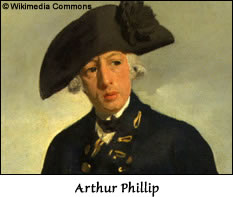
From the 18th January 1788 his jurisdiction extended from Cape York at the northern most tip of New Holland, to the extreme south of the continent, including Norfolk Island, New Zealand and Van Dieman’s Land. Having been claimed by Cook for Great Britain, this eastern land mass known as ‘New Wales’ or ‘New South Wales’ (NSW), allowed for the claims of other nations, especially the Dutch in western New Holland and the Portuguese in Timor and northern New Holland.
Albion (an ancient name for England), was the name considered by Phillip for this settlement. Although Sydney Cove was more prudent, being named after Britain’s Home Secretary, Lord Sydney, who had taken great responsibility in establishing the colony.
Within the first 2 or 3 days, a fresh water source for the settlement was found. Phillip named it ‘the tank stream’. On the 26th January 1788, Phillip began the actual setting up of camp, which was the humble start of Sydney town.
From the beginning, Phillip began a policy where men, “of no description could achieve a label, a post, a self definition”, and therefore a new career and life. This was demonstrated by the appointment of Harry Brewer to the post of Provost on the 26th January 1788. Arthur Phillip made time to give this midshipman a new identification as marshal of the colony who could bring charges against offenders before the military court.
Very early map of Sydney from 1789
Also from the beginning was wretchedness in this and all of the colonies to be founded. The need for shelter, food, vegetables and crops were greatest. The first crop of September 1788 failed miserably. The seed that had been planted rotted in the ground. The seasons were odd, inversed to the home that they had left behind. The knowledge or expertise of the newcomers to agriculture, or to build, was scarce, and the motivation to work even scarcer. Both convicts and marines stole rations which were limited and often traded or gambled them away. They became morose and mutinous with the alienation of this forgotten place. There was a ‘pervading loneliness’ in the tiny outpost of Sydney Cove. Convict discipline was harsh in this and other colonies, and those who would not work or who disobeyed orders were punished by flogging, being put in leg-irons, or being transported to a stricter penal colony. Port Arthur in Van Dieman’s Land, Moreton Bay (near today’s Brisbane) were stricter than Sydney Cove. Norfolk Island was the harshest of all.
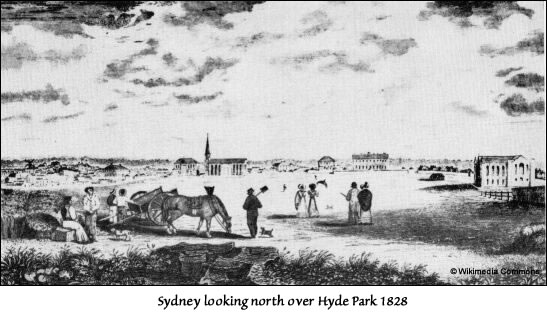
During Arthur Phillip’s five years of rule, he achieved self-sufficiency for the colony. His search for new pastures and farming land led to flourishing farms on the Parramatta and Hawkesbury River flats. The convict James Ruse was sent to farm one acre of land which later become known as Rose Hill. These would ultimately support the colony of Sydney Cove. The oceans off the southern coast of NSW were attracting sealers and whaling ships. In 1792 the first ships of the East India Company used Sydney Town as a trading port and stopover. The American trader, ‘Philadelphia’, followed. However Phillip was tired, in ill-health and disillusioned. As Tom Kenealy points out to us in ‘A Colony of Thieves’, Phillip’s plan was to have, convict and free”, equal before, “common law and the authority”. He demonstrated this by keeping rations and punishments equal for convict and free settlers alike. This was not received well, either by the free settlers or the troops, causing many pressures and problems within the settlement. Phillip left Sydney Town and the cove in December 1791, having laid the basis for a more egalitarian society in law and a freer one for the future.
The arrival in Port Jackson, of the ‘Second Fleet’ in June 1790 carried much needed provisions, with which Sydney Cove now had the chance of survival. It had taken 11 months for their journey, with hundreds of convicts dying among much suffering. Many arrived ill and in poor health. Among the ‘passengers’ was D’Arcy Wentworth, a surgeon who upon accepting a ‘self exile’, was quickly posted to Norfolk Island. He fathered numerous children with the convict Catherine Crowley. His eldest son, William Charles Wentworth, went on to become an explorer, founded NSW’s first newspaper, became a leader of the movement to abolish transportation and was instrumental in establishing representative government.
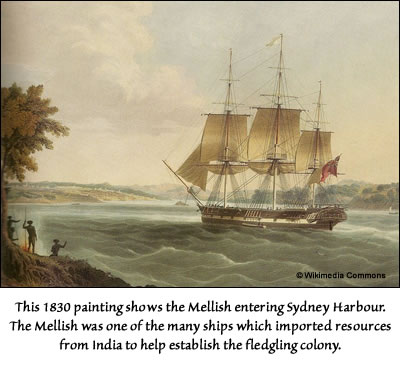
Lieutenant John Macarthur and his wife Elizabeth were also among the Second Fleet’s arrivals. Macarthur stood out from his fellow marines, and would become an important farmer and grazier in the colony. He was one of the founders of the wool industry, which laid the foundation for the future prosperity of Sydney Cove. NSW, governed by Lieutenant-Colonel Grose, granted all soldiers 100 acres of land and John Macarthur became a major beneficiary of this policy. He was granted 250 acres of farming land at Parramatta. Here he set up home which he named Elizabeth Farm. Macarthur experimented with Merino sheep, laying the basis for the wool industry.
The ‘Third Fleet’ arrived in 1791. It consisted of 10 transports with 1800 people, which included the first Irish convicts. Grose returned to England in December 1794, passing control of the colony to the Scotsman Major William Patterson, until Governor John Hunter arrived in September 1798.
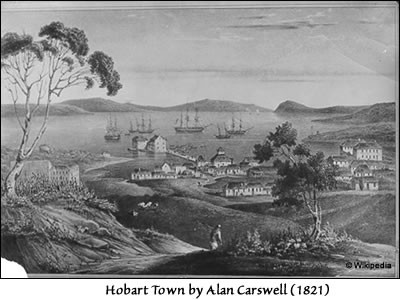
During Hunter’s rule, coal deposits were found at the mouth of the Hunter River, north of Sydney Town. The town of Newcastle was later established. Hunter founded a ‘military oligarchy’ and remained governor of NSW for 17 years. At this time, links with England became more tenuous. Britain was pre-occupied with the American and French wars and their aftermath, making New Holland and its NSW colony a low priority.
Under the governorship of Phillip Gidley King (1800-1805), one Robert Campbell established trade between Sydney Town and Calcutta. He had been refused before by Governor Hunter in 1798, but now King approved the venture. These trade links helped the colony to survive and grow. Campbell became a respected merchant in Sydney Cove and in 1804 built the first Australian made sailing vessel.
In 1795 Lieutenant Mathew Flinders, together with the surgeon, Bass, found that Van Dieman’s land was separated from NSW by a strait. In 1802 Flinders charted the whole coastline of New Holland, and was charged with mapping the southern coastline around Bass Strait (as it is now called). He continued north along the eastern coastline of NSW to Cape York. It was Flinders who popularised the name ‘Australis’ for the New Holland continent. He used the name consistently in his epic ‘A Voyage to Terra Australis’, detailing his finds and adventures, which was published in Britain in 1814.
Governor Lachlan Macquarie (1809-1821) saw the arrival of the free settlers, and new lands were opened up for farming. Growth followed rapidly, despite the long and arduous sea voyage. Settlers were attracted to making a new life with ‘virtually’ free land. These became the squatters who were considered the ‘pioneers of civilisation’ by Governor Sir George Gipps. It was the squatters who opened up new pastures and made discoveries to the north from Moreton Bay, which was founded in 1824 and later became Queensland. They travelled south to Portland Bay (Melbourne) and to the west of Sydney Cove. The less wealthy were annoyed by the system of ‘land grabbing’, but it wasn’t until 1831 that Governor Major General Sir Richard Bourke attempted to systemise sales of land to settlers. This was seen as ‘a mockery’, because the squatters were settling wherever a good living was to be had. It was Bourke who wrote that with a, “little care New South Wales will become a very valuable colony”.
In 1823, during the governorship of Sir Thomas Brisbane, NSW saw the appointment of the first Legislative Council. It consisted of six members acting in an advisory capacity to the governor and to the new Supreme Court. In 1824, Chief Justice, Sir Francis Forbes, introduced trial by jury, replacing the military courts for all civil cases, which had been in operation until then.
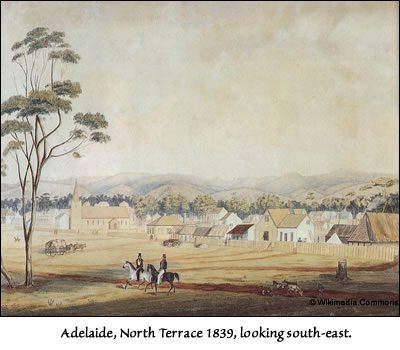
Governor Gipps announced in 1840 that transportation to the colonies was to cease. The exceptions were Van Dieman’s Land and Norfolk Island. It was the British Government and the squatters who wanted a renewal of convict transportation. The squatters became a powerful landowning class. As a result of opposition from the working and artisan classes, transportation of convicts to Sydney Town ended in 1840, although it continued in the smaller colonies of Van Diemen’s Land and Moreton Bay. However, in 1849, protesters in Sydney Town and in Melbourne prevailed and the convicts that landed were given ‘tickets of leave’ and sent ‘up country’.
It can be said that the first ‘sub-colony’ of NSW was founded by the ‘colonialists’. Although Port Phillip Bay had been sighted by Captain James Cook, no exploration was undertaken until 1801. Throughout his governorship, Phillip resisted a convict settlement at Port Phillip Bay. In 1803 David Collins attempted a settlement, but was soon sent on to Van Dieman’s Land.
A rich hinterland was explored by Andrew Hamilton Hume (born in the colony at Parramatta) and William Hovell in 1824, but until 1834 it was the domain of whalers and sealers, as well as the Aboriginal population. At this time the Henty family arrived. They were bitterly disappointed with the Swan River Settlement and Van Diemen’s Land, so came to Portland. Soon others followed; the ‘overstraiters’ from Van Diemen’s Land and squatters from NSW. The Portland colony suffered much civil unrest and had many major disputes. The killing of the natives, who were taking jumbucks (sheep) was extreme. The settlers had neither sympathy nor understanding for the native population that owned the land and its contents and who saw the newcomers as invading their lands.
Captain Lonsdale (1836) was sent to establish order and establish authority. Though the settlement was deemed illegal, Bourke ratified it in 1836. It was now called the Port Phillip District of NSW. In 1837 Bourke arrived to proclaim the founding of Melbourne (named after the Prime Minister of England). It became a very prosperous colony and developed a strong separatist movement, becoming independent of NSW and its ‘convict’ lifestyle. In 1852 Melbourne and the Port Phillip Bay district became a colony in its own right.
Although Van Dieman’s Land had been named by the Dutch navigator Abel Tasman in 1642, it was claimed by Phillip as part of NSW upon his arrival. Settlement commenced in 1803. Governor King sent Lieutenant John Bowen to establish a settlement for the severest convicts at Risdon Cove. The new governor was Lieutenant Governor David Collins (1804-10). The ‘HMS Calcutta’, with 299 convicts, 19 settlers with wives and children, and troops, arrived firstly at Port Phillip Bay. Then it was moved and Hobart Town was founded early in 1804.
Lieutenant Governor William Sorrell (1817-24) and George Arthur (1824-36) were the first governors of Hobart Town. Sealing, fishing and shipbuilding were the industries of the colony. International whalers made use of the town’s harbour, so that it became a major port for whaling ships. The free immigrants and ex-convicts developed basic commerce. It was George Arthur who opened the Port Arthur prison in 1833. He had the scope, efficiency and determination to expand and develop the colony. Hobart Town, though proclaimed a separate colony in 1825 and still part of NSW, had gained virtual independence from the Sydney Cove administration. Arthur was recalled in 1836 and Sir John Franklin arrived in 1837. Later governors were Sir John Eardley-Wilmot (1843-46) and Sir William Thomas Denison (1847-54). By 1852-53 transportation of British convicts to Hobart Town ended.
The Swan River Colony in western New Holland was the first free settlement. Founded in 1829, it was declared a British possession by Charles Fremantle. In April 1829 ‘HMS Challenger’ sailed to establish sovereignty at Swan River, and by June, ‘HMS Sulphur’ with a detachment of soldiers landed on its shores. The ship ‘Parmelia’ with Governor Sir James Stirling and 18 ship loads of free immigrants with their military attachments landed during 1829.
By 1830 Swan River showed 4000 free immigrants clearing the bush. Chairman of the Swan River Company, Thomas Peel, moved the colony 13 miles up river to present day Perth, because of its more fertile soil, although housing or improved living conditions were not provided. The settlement was no more than a ‘tent city’ where nothing was readied or prepared for the newcomers. By 1832 only 1500 people remained, and disappointment was severe. The harsh conditions, attacks by natives and ruined crops lead to the failure of the colonyand the majority of settlers left for either NSW or Van Dieman’s Land.
James Stirling (a Scots farmer from Surrey) and his wife Ellen (whose father was the wealthy MP John Mangles) became ‘the makers’ of the Swan River Colony, staying until 1839. During this time the colony suffered from a long term shortage of labour, and by 1850, local capitalists petitioned London for the use of convict labour. Even though they were successful, the settlement of Perth at Swan River continued to struggle for many years to come. In 1832 The Swan River Colony had its name changed to Western Australia. Transportation did not end in Western Australia until 1868.
The South Australian settlement was opened after the exploration of the Murray and Darling River schemes by Charles Sturt between 1829 and 1830. Captain Sutherland had, in 1819, found a group of escaped convicts, and ‘white’ seamen living, “like savages”, with some indigenous women. However it was when Edward Gibbon Wakefield, a social reformer and devout Quaker, formed the ‘Colonization Committee’ in 1831 that the, “right sort of immigrants”, were introduced to the southern settlement. After the British Parliament passed the 1834 act ‘Province of South Australia,’ the board of the South Australia Company nominated Captain John Hindmarsh as governor for the South Australian experiment. In 1838, 60 ships with 6000 new colonists arrived.
From the outset, when males of voting age reached the number of 10,000, South Australia was to have an elected Legislative Assembly. Autonomy and democracy was planned from the beginning, as was its capital city, Adelaide. Named after King George III consort, it was well planned and thought out by the surveyors General Colonel Francis Light and George Kingston.
In 1863 the Northern Territory was added to South Australia for development and protection. In 1869 the government in Adelaide founded the town of Port Darwin and then began building an overland telegraph line to connect these two towns. Hindmarsh was replaced by Governor Gawler who initiated a strong policy of large scale land cultivation, and who even thought that there was an abundance of wheat and sheep farming. He became bankrupt.
Delightful Dukkie
©Delightful Dukkie 2009
This is the third article Delightful Dukkie has written about Australian history for FTF Magazine. You can read the first two by using these links:-
Australia ~ The Great South Land
Sources and Further Reading
The Commonwealth of Thieves: THE SYDNEY EXPERIMENT
Tom Keneally
Random House Australia 2005
Australia: An Illustrated History: From Dreamtime to the New Millennium
A.K.Macdougall
The Five Mile Press Pty Ltd 2004
Encyclopedia Britannica Deluxe CD
Oxford University Press 2001